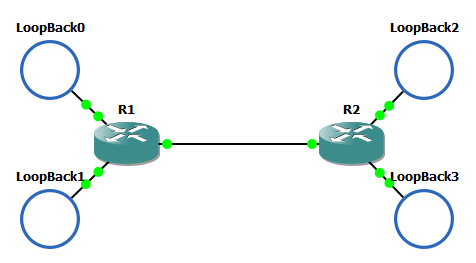Here you will find various Cisco CCNA 200-301 labs we have decided to provide FREE to you! These labs were created and we felt they were not advanced enough for our CCNA Lab Workbook. They are either not complex enough, do not cover multiple concepts, or do not have enough commentary explaining what we want to accomplish in each lab and why you are doing each step. These labs are basically just simple configurations and not what we would really call labs. Why? Because they do not really help you learn.
Objective: In this lab, you will configure static routes between two routers. This will allow your routers to route packets so that all routers and all hosts, or in this lab LoopBack interfaces, will be able to reach (ping) each other. Once your configuration is complete, you will use basic techniques to test your network’s connectivity.
Hardware Requirements
- Two routers with one serial port and at least two FastEithernet of GigabitEthernet interfaces
- One back to back DTE/DCE serial cable
- IOS version 12.x or later
- A PC running a terminal emulation program
- Cisco console kit
Setup
- Configure the cabling as shown in the network diagram
- If the routers have a startup-config, erase it and perform a reload of the routers.
Configuration of Router 1
Router>enable
Router#conf t
Router(config)#Hostname R1
R1(config)#enab pass cisco
R1(config)#line vty 0 4
R1(config-line)#pass cisco
R1(config-line)#login
R1(config)#int s0
R1(config-if)#ip add 10.1.1.1 255.255.255.252
R1(config-if)#clock rate 64000
R1(config-if)#no shut
R1(config)#int lo0
R1(config-if)#ip add 192.168.0.1 255.255.255.0
R1(config-if)#no shut
R1(config)#int lo1
R1(config-if)#ip add 192.168.1.1 255.255.255.0
R1(config-if)#no shut
R1(config)#ip route 192.168.2.1 255.255.255.0 10.1.1.2
R1(config)#ip route 192.168.3.1 255.255.255.0 S0/0/0
R1(config-if)#end
R1#write
R1#
Configuration of Router 2
Router>enable
Router#conf t
Router(config)#Host R2
R2(config)#ena pass cisco
R2(config)#line vty 0 4
R2(config-line)#password cisco
R2(config-line)#login
R2(config)#int s0
R2(config-if)#ip add 10.1.1.2 255.255.255.252
R2(config-if)#no shut
R2(config)#int lo2
R2(config-if)#ip add 192.168.2.1 255.255.255.0
R2(config-if)#no shut
R1(config)#int lo3
R1(config-if)#ip add 192.168.3.1 255.255.255.0
R1(config-if)#no shut
R2(config-if)#exit
R2(config)#ip route 192.168.0.1 255.255.255.0 10.1.1.1
R2(config)#ip route 192.168.1.1 255.255.255.0 S0/0/0
R2(config)#end
R2#write
R2#
Testing of Router 1
R1#ping 192.168.2.1
Type escape sequence to abort.
Sending 5, 100-byte ICMP Echos to 192.168.1.1, timeout is 2 seconds:
!!!!!
Success rate is 100 percent (5/5), round-trip min/avg/max = 56/60/68 ms
R1#ping 192.168.3.1
Type escape sequence to abort.
Sending 5, 100-byte ICMP Echos to 192.168.1.2, timeout is 2 seconds:
!!!!!
Success rate is 100 percent (5/5), round-trip min/avg/max = 32/32/32 ms
R1#show cdp neig
Capability Codes: R – Router, T – Trans Bridge, B – Source Route Bridge
S – Switch, H – Host, I – IGMP, r – Repeater, P – Phone
Device ID Local Intrfce Holdtme Capability Platform Port ID
Router Gig 0/0/0 172 R ISR4300 Gig 0/0/0
R1#Sho ip route
(Output omitted)
Gateway of last resort is not set
10.0.0.0/8 is variably subnetted, 2 subnets, 2 masks
C 10.1.1.0/30 is directly connected, GigabitEthernet0/0/0
L 10.1.1.1/32 is directly connected, GigabitEthernet0/0/0
192.168.0.0/24 is variably subnetted, 2 subnets, 2 masks
C 192.168.0.0/24 is directly connected, Loopback0
L 192.168.0.1/32 is directly connected, Loopback0
192.168.1.0/24 is variably subnetted, 2 subnets, 2 masks
C 192.168.1.0/24 is directly connected, Loopback1
L 192.168.1.1/32 is directly connected, Loopback1
S 192.168.2.0/24 [1/0] via 10.1.1.2
S 192.168.3.0/24 is directly connected, GigabitEthernet0/0/0
Testing of Router 2
R2#ping 192.168.0.1
Type escape sequence to abort.
Sending 5, 100-byte ICMP Echos to 192.168.1.1, timeout is 2 seconds:
!!!!!
Success rate is 100 percent (5/5), round-trip min/avg/max = 32/32/36 ms
R2#ping 192.168.1.1
Type escape sequence to abort.
Sending 5, 100-byte ICMP Echos to 192.168.1.2, timeout is 2 seconds:
!!!!!
Success rate is 100 percent (5/5), round-trip min/avg/max = 60/63/72 ms
R2#show cdp neig
Router#sh cdp neigh
Capability Codes: R – Router, T – Trans Bridge, B – Source Route Bridge
S – Switch, H – Host, I – IGMP, r – Repeater, P – Phone
Device ID Local Intrfce Holdtme Capability Platform Port ID
Router Gig 0/0/0 156 R ISR4300 Gig 0/0/0
R2#sho ip route
(Output omitted)
Gateway of last resort is not set
10.0.0.0/8 is variably subnetted, 2 subnets, 2 masks
C 10.1.1.0/30 is directly connected, GigabitEthernet0/0/0
L 10.1.1.2/32 is directly connected, GigabitEthernet0/0/0
S 192.168.0.0/24 [1/0] via 10.1.1.1
S 192.168.1.0/24 is directly connected, GigabitEthernet0/0/0
192.168.2.0/24 is variably subnetted, 2 subnets, 2 masks
C 192.168.2.0/24 is directly connected, Loopback2
L 192.168.2.1/32 is directly connected, Loopback2
192.168.3.0/24 is variably subnetted, 2 subnets, 2 masks
C 192.168.3.0/24 is directly connected, Loopback3
L 192.168.3.1/32 is directly connected, Loopback3
R2#
End of Lab

